 |
792 |
|
Year: 2011 Vol. 15 Num. 3 - Jul/Set - (16º)
DOI: 10.1590/S1809-48722011000300016
|
|
 |
|
|
| Long-term results by using cochlear Implants on children: Systematic review |
|
| Author(s): |
| Liège Franzini Tanamati1, Orozimbo Alves Costa2, Maria Cecilia Bevilacqua3
|
|
|
| Key words: |
| cochlear implant, evaluation of results (health care), follow-up studies. |
|
|
 |
| Abstract: |
Introduction: Cochlear Implant (CI) benefits given to children in the first years of usage have been thoroughly described in literature. Nonetheless, studies reporting the results after the device has been long used are scarce. Objective: Review the available evidence in literature to answer the query: "Did Cochlear Implant effectively contribute to develop the communication abilities in children and young adults who grew up with this device? Method: To answer the suggested query, a systematic literature review was performed. Several electronic databases and congress records have been selected to find the evidence regarding the long-term CI results. The likely significant titles to answer the objective of the systematic review were retrieved and reviewed by using a data analysis protocol. For every article encompassed in the present systematic review, short notes were made on a filing card as well as the classification, according to evidence level and degree of recommendation. Data synthesis: Fifteen studies fulfilled the requirements and were included in the systematic review. The achieved results showed that the first generation of implanted children reached levels of linguistic and academic proficiency similar to normal hearing individuals at the same age. Final Comments: CI effectively contributed to develop the functional communication abilities in children and young adults who grew up with this electronic device.
|
|
 |
INTRODUCTION
In 1990, FDA (Food and Drug Administration) approved the cochlear implant (CI) to be implanted in children as young as two years old (1). Ever since, parallel to both the scenario of criteria-expanding scenario of CI in the pediatric population and the technological development applied to the manufacturing of the devices, an increasing number of children has been implanted, and, subsequently, ongoing clinical researches and studies are conducted in order to measure the results provided by the CI, especially as a result of the characteristics of each user and time of device utilization.
CI is considered the most effective technological resource in the treatment of severe-to-profound sensorineural pre-lingual hearing impairment currently available. It is an intervention whose effects and results for the children's communication skills are obtained over the years (2).
Short-term results, measured during the early years of IC utilization in children with pre-lingual hearing impairment, have been thoroughly described in the literature. Generally speaking, the results of these studies showed clear benefits with the use of CI, whether in the receptive or expressive language, in the process of academic learning, or in passion, social and emotional areas. However, although there is a consensus, particularly with regard to an improvement in environmental sound perception, speech, and in other areas of language development, there is an agreement between the studies performed in the first years of CI use regarding the diversity of results observed in implanted children. Several factors described in the literature, such as etiology, age at implantation, the presence of residual hearing, auditory rehabilitation, family participation in the therapeutic process, can potentially contribute to a diversity in the performance of CI-implanted children (3, 4.5).
Yet, it is unclear whether this variability in results obtained in children using the device for a short time remains after using the IC in the medium and long terms, or whether satisfactory benefits will be achieved by CI users after many years using the device, having their normal hearing peers as references. Studies that have evaluated the results after 7 years of use are very scarce (6).
During the utilization of the CI device and the therapeutic process, families and professionals working with CI-implanted children may face unusual situations and results, filled with doubts and even annoyances. Not all implanted children are capable of achieving the results expected by the family in the first years using the device. Several factors may interfere with this acquisition process of auditory skills and language by way of CI, and, eventually, lead to a delay in acquiring these skills and in some cases, in the child's inability to reach levels of communication skills appropriate for his/her age (7).
In addition, the development of listening and oral language skills and the pace of development of these skills are not the same for all children (8, 9, 10, 11). What level of communication skills the child will reach and how long it will occur, or if implanted children at older ages will be, over time, able to achieve the same results of children implanted at younger ages, are questions whose answers are not obtained within the first years using the device (12).
Another important factor to be considered with regard to the importance of long-term studies is associated with the information relating to the functionality of the device and the possible complications after years of use. During the process to decide about a surgery and choose the CI model and trademark, information about the integrity of devices derived from either historical data or more current evaluations is fundamental and it must be provided in a transparent, standardized and easy-to-understand format, with a view to helping professionals involved in counseling, the CI candidates and their family members (13).
The studies in children after long-term CI utilization represent a way to guide professionals and families both regarding the therapeutic process and counseling about expectations and to better understand the factors involved in development processes of communicative, educational and occupational skills of children who will grow up using the IC. As the main untreated difficulties are observed over time, it can guide practitioners to perform a previous therapeutic intervention in order to contribute to greater adaptation to society (6, 14, 15, 16).
Considering the importance of long-term studies with CI children, the aim of this study was to determine whether, after several years using CI, satisfactory outcomes were obtained in relation to the communication skills of adolescents and young adults who grew up with the electronic device. A systematic literature review was conducted in order to gather the available evidence in the literature to answer clinical questions. This study was approved by the Ethical Committee for Analysis of Research Projects - CAPPesq with the research protocol Nº 0685/08.
METHODOLOGY OF THE SYSTEMATIC
LITERATURE REVIEW
One of the fundamental items of the methodology of systematic review is the formulation of the research question. Considering the aim of the systematic review of the present study, the question was: Has the Cochlear Implant effectively contributed to the development of communication skills in adolescents and young adults who grew up with this device?"
Criteria for selecting studies
In this step, after the question was established, the search for evidence began by determining the criteria of selection of primary studies. Based on these criteria, it is expected that all important items or items that may have some impact on the completion of the systematic review are found and included (17).
1. Types of Studies
The studies published in the last ten years, i.e., between 2000 and 2010 in English, Spanish or Portuguese, were selected for analysis. Regarding the level of scientific evidence due to scarcity of studies with evidence levels 1 and 2 in the area of Audiology, articles with evidence levels of 3, 4 and 5 were also selected for a systematic review of the present study (18). Table 1 shows the levels of scientific evidence, adapted by COX (19) for the area of Audiology.
2. Participants
Since the objective of this systematic review was to assess the long-term IC performed in children, the main inclusion criterion related to the time using the device included the studies conducted with adolescents or young adults using it for at least seven years. With regard to the age when the surgery was performed and the hearing loss started, studies with pre-lingual hearing impaired groups who underwent surgery in adolescence or adulthood were not accepted within the inclusion criteria. Studies with group of post-lingual hearing-impaired adults were also excluded.
3. Intervention
The methodology and the tests used in studies intended to evaluate the performance of cochlear implant users were not considered as exclusion criteria. Studies whose intervention was performed a group using the device for more than 7 years were selected, in compliance with the other selection criteria related to the participants.
4. Clinical results
To evaluate the effectiveness of the Cochlear Implant device after years of utilization, the clinical results considered to be relevant to the question of this systematic review included the following categories of interest: results expressed in percentage of right answers in tests of perception and speech intelligibility, results expressed by grading scales of the development of hearing, language and speech intelligibility skills and description of both the educational and/or professional status and the utilization of the device.
Finding studies
1. Describers
The describers or keywords used to locate the relevant studies to answer the question established in this systematic review are shown in Table 2.
2. Search strategy
The search strategy is the syntax of the strategy used to search bibliographical references through the databases. For this study, a specific search strategy was created by using the describers into groups with at least two key words: cochlear implantation AND OR child OR adolescent young adult, cochlear implantation AND follow-up studies OR Outcomes. Additional terms were also used: cochlear implantation AND speech perception OR speech intelligibility OR language OR educational status.
3. Sources of study
For the bibliographical search of possible articles to be included in the systematic review, the following search sources were viewed:
-Electronic databases: The search for primary studies was then held in electronic data bases: Lilacs, Medline, SciELO and Cochrane Library, Pubmed, Embase, Institute for Scientific Information (ISI) and Science Direct. The last research performed in electronic data bases occurred in September/2010. After this date, the "e-alert" service, available in the databases, was triggered.
-Records of Congress National: in the country, it stands out for its history and its importance in the national scientific scene, the International Meeting of Audiology (EIA). By the year 2008, the search was carried out in a manual, printed in the records of the event. After 2008, the records of events, available on the website http://www.audiologiabrasil.org.br available were accessed.
-Other databases: considering the importance of conducting the bibliographical research for a systematic review of different types of databases, the search on specific sites of (national and international) dissertations and theses was performed on digital databases. Digital Dissertation Abstracts, Brazilian Digital Library of Theses and Dissertations, Digital Library of Theses and Dissertations of USP.
Identification, selection, data extraction and inclusion of studies
From the application of search strategy containing the describers defined, the identification of titles was performed in different electronic databases.
In order not to take the risk of excluding important studies for the review, after a consensus meeting, two revisers selected all the titles identified, whether accompanied by an abstract or not, that were potentially relevant to the object of study. After the relevant titles were selected, the articles were thoroughly retrieved and each article was evaluated by a protocol containing the topics: type of study, participants, interventions taken, and results found.
The included studies included the eligibility criteria set at the beginning of the methodological protocol of this review, in order to answer the question established in this systematic review. The main data of each retrieved article were thoroughly collected by a standardized protocol form for this study.
Analysis and data presentation
In this systematic review, after completing the data protocol containing detailed information of each article, the articles were then classified as: the quality of evidence (Table 3) and the level of evidence (Table 1), adapted by Cox (19) for the area of Audiology.
As regards the presentation of data, relevant information of each article, as well as the classification of the degree of recommendation were gathered in tables to be easily consulted and accessed during the presentation and discussion of results.
RESULTS OF THE LITERATURE REVIEW
As to the selection of potentially relevant studies for the systematic review
1. Results in electronic databases:
From the search strategy in different electronic databases, 282 titles with or without summary, potentially relevant to the object of study of this systematic review, were identified. The titles identified in each of the databases are described in Table 4.
Out of the 282 titles, 82 appeared in more than one electronic database. The 197 duplicate titles were disregarded, remaining a total of 85 titles potentially relevant to systematic review.
2. Results in Records of Congress
From the manual and digital survey referring to the records of the International Meeting of Audiology conducted from 1985 to 2010, studies potentially relevant to this systematic review were not found.
3. Results in other databases
Besides searching electronic databases for scientific articles, the bibliographic research on digital databases of dissertations and theses was also conducted. From this search, two theses found in "Digital Dissertation Abstracts" were selected.
As for the analysis of selected studies
1. Electronic databases
Out of the 85 titles selected to retrieve articles, only one cannot be recovered because it is not available for electronic access in the country. (Svirsky et al., 2007. "The effects of age at implantation on speech intelligibility in pediatric cochlear implant users: Clinical outcomes and sensitive periods. "). Therefore, a total of 84 articles was retrieved.
After completely reading the articles, only 15 have met the eligibility criteria of this study and were included in the systematic literature review. Sixty-nine articles were not included because they had one or more factors of exclusion. Table 5 presents the criteria that led to the exclusion of the retrieved articles and in how many articles in the exclusion criterion occurred.
The complete references of the 15 articles included in the systematic review and the main results collected from the protocol are described in Tables 6 and 7, respectively.
2. Other databases
Two theses found in "Digital Dissertation Abstracts" were selected for analysis due to having titles potentially relevant to the object of study of this systematic review: "The experience of adolescents with cochlear implants" (KE Kops, 2003) and "Perception and production of speech intonation in pediatric cochlear implant recipients and children with normal hearing" ( SC Peng, 2005).
However, both were excluded after the work was evaluated in details due to not meeting the selection criteria of this systematic review regarding the objective of study, at the time of CI utilization, and the age when surgery was performed and the hearing impairment started.
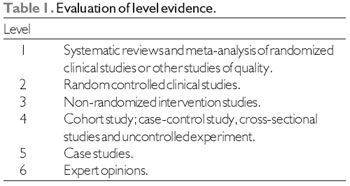
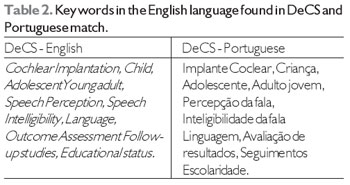
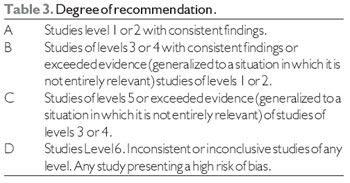
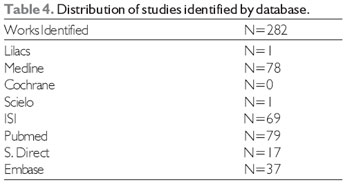
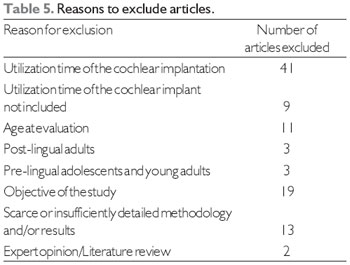
DISCUSSION
Considering the importance to know the medium and long-term achieved results and the scarcity of this type of study in the CI pediatric population, the objective was to determine, by systematically reviewing the literature, the CI effectiveness to the development of communication skills of adolescents and young adults who grew up using the electronic device.
A prevalent number of studies in literature evaluated the users using the device for as long as six years. At the end of bibliographical research, only a 15-article group, all of which were primary, was selected for appraisal, as they met the inclusion criteria to answer the question of this systematic review. Among the articles included, 8 were prospective studies, 2 retrospective, 4 transverse and 1 longitudinal case study. The studies showed a degree of recommendation C and D.
The first study evaluating the benefits of long-term IC utilization in children was performed by Tyler (2000). At the time, only studies with children using cochlear implants for five years after surgery had been conducted. The author found the possible variants that could contribute to the different levels of benefits provided by the CI to develop listening skills during the first seven years of use of the device. Ever since, other long-term studies were conducted in international literature. However, considering that the FDA approved the appointment of the IC in children from two years old, in 2010, completing 20 years of the first surgeries in children, the publication of a greater number of articles addressing the results of long-term IC utilization in the pediatric population was expected. According Beadle et al. (2005), possible explanations for the still low number of such studies are due to methodological problems and the presentation method of the results measured.
Omission of the demographic data or the results of evaluations for each user, non-standardization of protocols and the methodology used in the testing, omission of users with poor results, grouping of users according to different variants, problems with the study design and inadequate follow-up, are some of the most common problems found in studies evaluating the cochlear implant users over time (Waltzman et al. 2002; BEADLE et al., 2005; VENAIL et al., 2010).
Another negative aspect is that not all studies have addressed all areas of interest when monitoring of users, such as the development of listening skills, oral language, the educational and occupational status.
In this systematic review, only two studies (BEADLE et al., 2005 and UZIEL et al., 2007) covers all the topics among the areas of interest. Most of the studies addressed only one area of interest, among which six studies evaluated only the auditory skills (TYLER,2000; WALZMAN et al., 2002; MANRIQUE et al., 2004; HAELSEN et al., 2005; GEERS et al., 2008; DAVIDSON et al., 2010; SAID et al., 2010), three studies have examined only the speech intelligibility (PENG et al., 2004, CONNOR, 2006; HABIB et al., 2010) and the educational and occupational status was studied by VENAIL et al. (2010). Combined areas, auditory/speech intelligibility skills and listening skills/educational status were evaluated in two studies carried out by COLLETTI (2009) AND SPENCER et al. (2004), respectively.
As to the procedures used, the studies that specifically evaluated the auditory skills used recognition tests of monosyllabic words, sentences in silence/noise and scale of auditory skills (TYLER,2000; WALZMAN et al., 2002; MANRIQUE et al., 2004; SPENCER et al., 2004; BEADLE et al., 2005; HAELSEN et al., 2005; UZIEL et al., 2007; GEERS et al., 2008; COLLETTI, 2009; DAVIDSON et al., 2010; SAID et al., 2010). Studies in Spanish and Portuguese have also used two-syllable word lists (MANRIQUE et al. 2004; SAID et al., 2010). Despite the methodological variables applied, we observed that most participants in these studies achieved complex levels of auditory skills. Consequently, most CI users were able to recognize speech without the help from orofacial reading and, therefore, they were able to complete the evaluation procedures of speech recognition in an open set.
Still regarding the evaluation of listening skills, only two studies performed by UZIEL et al. (2007) and DAVIDSON et al., (2010) measured the sentence recognition in noise (S/N ratio +10 dB). Considering the importance that the evaluation of speech perception in noise plays when evaluating benefits and limitations of using electronic devices (DUNCAN AND AARTS, 2006) and, due to the fact that a considerable number of users has reached levels of auditory skills necessary for speech recognition, reaching a plateau in the tests performed in silence, a higher number of studies with tests of speech perception in noise was expected.
Six studies evaluated the speech intelligibility after at least 7 years of CI use. Again, the studies used different methodologies. Among them, three used the "Speech Intelligibility Rating" - SIR scale (BEADLE et al. 2005; UZIEL et al. 2007; COLLETTI, 2009), only one study used the transcription method (CONNOR, 2006) and two studies measured the speech intelligibility by using the transcript method along with a scale of five intelligibility levels (PENG et al. 2004; HABIB et al., 2010). There was a wide range in the results achieved by the transcription method, and the minimum and maximum percentages obtained by the transcription method varied from 5.5% to 100%.
Despite the variability in the intelligibility of CI users, most participants reached satisfactory levels in the intelligibility scales. The results suggest that after 7 years of using CI, the message orally transmitted by most children who grew up with the device can be understood by listeners not experienced in the speech of the hearing-impaired. However, not all users, even after 10 years using the device, failed to achieve satisfactory results in sending the message content through oral language (PENG et al. 2004; UZIEL et al. 2007; HABIB et al., 2010).
In relation to occupational and educational results, the studies collected information by interviewing the user and/or his/her family. Generally speaking, the features raised by the authors showed that children's admission in regular schools was increasing with the utilization time of CI and that users have reached satisfactory educational levels. Some authors have noted that users tend to follow the educational standard presented by their parents (SPENCER et al., 2004). Although most participants in regular school or university, there was delay in the acquisition of academic skills and recorded episodes of school failure, particularly in teaching intermediate / medium (SPENCER et al. 2004; GEERS et al. 2008; VENAIL et al., 2010).
There were important differences between the studies related to the development pace of communicative skills, presence of plateaus in the development, as well as the diversity of the results obtained in the last evaluation. Such diversity was shown in all areas evaluated by the studies, the authors assigned the results of this diversity partially to the existence of certain factors.
Presence of residual hearing in the severe frequencies and speech understanding prior to CI surgery were the factors associated with the best results obtained after years using the CI to TYLER (2000) and WALTZMAN et al. (2002). The sensory deprivation time and age in implantation were the mostly agreed variants among the studies regarding the successful predecessors of for CI users. Younger age at implantation, specifically taking into consideration the age group until two years of age, along with the use of oral communication were related to the best pace of skill acquisition, the best results of speech perception and intelligibility after several utilization years and the tendency to be closer to the results obtained in individuals listeners. Instead, the worst results in all areas evaluated were obtained by users with a greater sensory deprivation (TYLER 2000; WALTZMAN et al. 2002; MANRIQUE et al. 2004; PENG et al. 2004; SPENCER et al. 2004; GEERS et al. 2008; COLLETTI, 2009; HABIB et al. 2010; SAID et al. 2010; VENAIL et al., 2010).
Based on these results, the authors stressed the importance of performing the CI early, in order to avoid periods of sensory deprivation. The long-term results with the CI-implanted users at different ages suggest that even after years of device utilization, the children submitted to the IC late may not achieve the same results as the children implanted at younger ages (TYLER, 2000; WALTZMAN et al. 2002; MANRIQUE et al. 2004; SPENCER et al. 2004; GEERS et al. 2008; COLLETTI, 2009; VENAIL et al. 2010).
All the different models of devices evaluated provided long-term benefits to its users and their difference was not statistically significant (SAID et al., 2010). However, the use of different and more modern speech coding strategies was an important aspect discussed in some studies and that significantly contributed to the achievement of better results both in evaluation tests of auditory skills and in the speech intelligibility test (PENG et al., 2004; DAVIDSON et al., 2010 and SAID et al., 2010).
The results of the studies were also positive as to the integrity question and the long-term device operation, even after ten years of use. According to the authors, although there is the need for reoperation, the users did not worsen in hearing perception after being re-implanted. Out of the three studies described the occurrence of failures in the internal device, there was the need to re-implant 9 cases in the study of WALTZMAN et al. (2002), 8 cases in the study of BEADLE et al. (2005) and 11 cases in the article BY UZIEL et al. (2007).
CONCLUSION
After the bibliographical survey and the analysis of the scientific evidence found on the studies included in this systematic review of literature were performed, it was possible to imply that the authors agreed in the studies included in the present systematic review about the conclusions regarding the benefits due to the time of CI utilization.
The achieved results suggested that the long-term CI utilization provided the first generation of CI children with a significant progress and levels. of language and educational competency similar to normal hearing individuals at their age. In addition to the CI contribution to the wide-ranging aspects inherent to the development process of communicative and educational skills and the improvement in the quality of life, the results of the studies revealed the functional CI effectiveness, hence consolidating it as a notably reliable and endurable device, even after ten years of utilization.
However, certain diversity was observed in the results achieved after a period longer than 7 years of CI utilization. For some authors, the longest time of sensorial deprivation and the utilization of less technologically advanced devices found in the first generation of implanted children can have firmly contributed to the existence of such a diversity.
Long-term studies with the subsequent generation s of CI children are required. It is expected that the new generation of Cochlear Implantation users, which was submitted to the surgical procedure at younger ages and with more advanced technological devices can achieve still better results through the time of utilization.
REFERENCES
1. Chin SB, Tsai PL, Gao S. Connected speech intelligibility of children with cochlear implants and children with normal hearing. Am J Speech Lang Pathol. 2003, 12(4):440-51.
2. Archbold S, O'Donoghue GM. Ensuring the long-term use of cochlear implants in children: the importance of engaging local resources and expertise. Ear Hear. 2007, 28(2):3S-6S.
3. Richter B, Eissele S, Laszig R, Löhle E. Receptive and expressive language skills of 106 children with a minimum of 2 years experience in hearing with a cochlear implant. Int J Pediatr Otorhinolaryngol. 2002, 64(2):111-25.
4. Calmels MN, Saliba I, Wanna G, et al. Speech perception and speech intelligibility in children after cochlear implantation. Int J Pediatr otorhinolaryngol. 2004, 68:347-51.
5. Artières F, Vieu A, Mondain M, Uziel A, Venail F. Impact of early cochlear implantation on the linguistic development of the deaf child. Otol Neurotol. 2009, 30:736-42.
6. Archbold AM, Nikolopoulos TP, Lloyd-Richmond H. Long term use of cochlear implant system in paediatric recipients and factors contributing to non-use. Cochlear Imp Inter. 2009, 10(1):25-40.
7. Nicolas JG e Geers AE. Will they catch up? The role of age at cochlear implantation in the spoken language development of children with severe to profound hearing loss. J Speech Lang Hear Res. 2007, 50:1048-62.
8. Gordon KA, Daya H, Harrison RV, Papsin BC. Factors contributing to limited open-set speech perception in children who use a cochlear implant. Int J Pediatr Otorhinolaryngol. 2000, 56(2):101-11.
9. Robbins AM, Koch DB, Osberger MA, Zimmerman-Phillips S, Kishon-Rabin L. Effect of age at cochlear implantation on auditory skill development in infants and toddlers. Arch Otolaryngol Head Neck Surg. 2004, 130:570-78.
10. Eisenberg LS, Johnson KC, Martinez AS, Cokely CG, Tobey EA, Quittner AL, Fink NE, Wang NY, Niparko JK. CDaCI Investgative Team. Speech recognition at 1-year follow-up in the childhood development after cochlear implantation study: Methods and preliminary findings. Audiol Neurootol. 2006, 11(4):259-68.
11. Wie OB, Falkenberg ES, Tvete O, Tomblin B. Children with a cochlear implant: characteristics and determinants of speech recognition, speech-recognition growth rate, and speech production. Int J Audiol. 2007, 46(5):232-43.
12. Tomblin JB, Peng S, Spencer LJ, Lu N. Long-term trajectories of the development of speech sound production in pediatric cochlear implant recipients. J Speech Language Hearing Research. 2008, 51: 1353-68.
13. Battmer RD, Linz B, Lenarz T. A review of device failure in more than 23 years of clinical experience of a cochlear implant program with more than 3.400 implantees. Otol Neurotol. 2009, 30(4):455-63.
14. Wang NM, Huang TS, Wu CM, Kirk KI. Pediatric cochlear implantation in Taiwan: Long-term communication outcomes. Int J Pediatr Otorhinolaryngol. 2007, 71(11):1775-82.
15. Huber M, Wolfgang H, Klaus A. Education and training of young people who grew up with cochlear implants. Int J Pediatr Otorhinolaryngol. 2008, 72(9):1393-403.
16. Kaplan DM e Puterman M. Pediatric Cochlear Implants in prelingual deafness: medium and long-term outcomes.IMAJ. 2010, 12:107-9.
17. Sampaio RF e Mancini MC. Estudos de Revisão Sistemática: Um guia para síntese criteriosa da evidência científica. Rev Bras Fisiot. 2007, 11(1):83-9.
18. Mendes TM, Alvarenga KF. Capacitação de profissionais da saúde na área de saúde auditiva: revisão sistemática. Rev Soc Bras Fonoaudiol. 2009, 14(2):280-6.
19. Cox RM. Waiting for evidence-based practice for your hearing aid fittings? It´s here! The Hearing Journal. 2004, 57(8):10-7.
1) Attending Doctor Degree in Physiopathology of the Communication Disorders at the University of São Paulo's Medical School - FMUSP. Phonoaudiologist of the Bionic Ear Department of the Samaritano Hospital of São Paulo.
2) Full Processor of University of São Paulo. Coordinator of the Bionic Ear Department of the Samaritano Hospital of São Paulo.
3) Full Processor of University of São Paulo. Coordinator of the Rehabiliation Hospital of Anomalies' Department of Audiological Research and Coordinator of the Bionic Ear Department of the Samaritano Hospital of São Paulo.
Institution: University of São Paulo's Medical School - FMUSP. São Paulo / SP - Brazil. Mailing addrss: Liège Franzini Tanamati - Rua Cincinato Braga, 59. Conjunto 5d1 -Bairro: Paraíso - São Paulo / SP - Brazil - ZIP Code: 01333-011 - Telephone: (+55 11) 3288-4186 / 3262-0675 - Email 1: liegeft@hotmail.com Email 2: liege_tanamati@yahoo.com.br Email 3: liegeft@usp.br
Article received on January 19, 2011. Article approved on March 9, 2011.
|
|
 |
|
|
